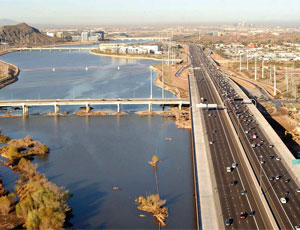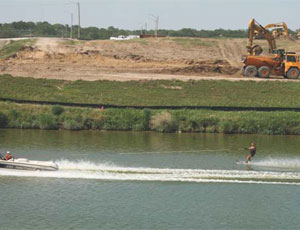The State Route 202 expansion project in Phoenix and its suburbs is heading for early completion.
The $188-million reconstruction of SR 202—an integrated joint venture of lead partner Kiewit Corp.’s Phoenix office and Sundt Construction of Tempe for the Arizona Dept. of Transportation—adds a 10-mi eastbound through-lane and auxiliary lanes between Interstate 10/State Route 51 and State Route 101 and a 2-mi westbound through-lane and auxiliary lane between SR 101 and Scottsdale Road.


Designed by San Francisco-based URS Corp., the design-build project also directs the Kiewit/Sundt team to manage traffic control during construction; widen the roadways and 22 bridges including the 1-mi-long Salt River bridges; reconstruct ramps; build noise and retaining walls; modify the drainage system; complete landscaping; and install an updated freeway management system.
“It’s one of the largest projects we’ve ever done,” says ADOT spokesman Doug Nintzel. “It’s been progressing without a lot of fanfare, but that has to do with the project team’s ability to balance construction requirements with traffic management and public notification.”
Begun in December 2008, the project is scheduled for completion in late summer, eight months ahead of the maximum contract duration set by ADOT.
The team has used the design-build format to significant benefit, especially for fast-tracking.
“With the project covering a 10-mi stretch of freeway, design-build was selected to give us the best opportunity to get the job done as quickly and efficiently as possible,” says ADOT project manager Annette Riley. “Our previous experience with design-build told us that this project was a good candidate.
“There’s also a higher level of intensity in getting the construction done in multiple phases as plans move through the approval stage.”
Coordination and planning have been essential for such a large project. At peak, approximately 500 contractor and subcontractor employees were onsite simultaneously.
Traffic control also required close communication with the cities. “The project’s community relations team worked with management to address concerns from businesses such as nearby hotels,” Riley says. “A project like this requires hours and hours of work on traffic control and phasing plans in order to limit impacts on drivers.”
Closings also required careful planning by Kiewit/Sundt and ADOT. The team had to maintain the same number of lanes during construction as before construction, so restrictions were limited to nights and weekends, says Travis J. McCarthy, PE, Sundt’s deputy project manager. “Sometimes completely closing a ramp to get the construction done quickly is more advantageous than trying to build half a ramp,” McCarthy says.
The most challenging section, for a variety of reasons, has been working on Arizona’s longest bridges, those that cross the 202 over the Salt River. For example, the team had to truck in temporary fill to construct an access roadway for equipment into the riverbed.
Fortunately, the area’s record winter rains were not detrimental. “We were able to remove the access road just as the rains were having the most impact in the Valley,” says Allen Mills, Kiewit’s project manager.
The team had to coordinate with the U.S. Army Corps of Engineers and the Flood Control District of Maricopa...

Post a comment to this article
Report Abusive Comment